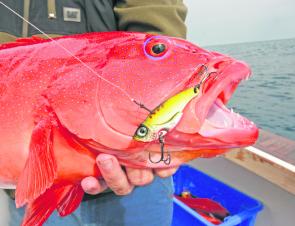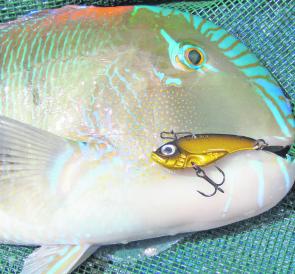The first blade lure was commercially produced in the US in the late 1950s, but it took nearly half a century for the Australian market to realise the potential for these metal vibration lures.
In the early days, the first blades ranged from 1/8-3/4oz, however, Aussies have taken it one step further and have gone bigger and better than those pioneer models with the already released 1-2oz TT Switchblade HD and a 4oz model on the drawing board.
Add to this a growing list of other manufacturer’s offerings in larger sizes and our bigger blade market, it is now starting to shape up into a very interesting niche market.
The blade’s biggest fish attracting feature is the vibration put out by its vigorous wobble at slow and fast speeds. It is this vibration that alerts fish to its presence. Blade lures are designed to take advantage of the fish’s natural offensive and defensive system known as the lateral line.
The lateral line is sensitive to differences in water pressure, similar to the affect of air pressure on the swim bladder. These differences may be caused due to changes in depth or to the current-like waves made by approaching objects. The basic sensory unit of the lateral line system is the neuromast, which is a bundle of sensory and supporting cells whose projecting hairs are encased in a gelatinous cap. The neuromast continuously send out trains of nerve impulses to the brain of the fish, effectively telling the fish what is going on around it.
Neuromasts may occur singularly in small groups called pit organs or in rows within grooves or canals when they are referred to as the lateral line. The lateral line runs along the sides of the body onto the head where it divides into three branches, two to the snout and one to the lower jaw. A blade lure will set up a pressure wave in the water that is detectable by the lateral line. It also sets up a bow wave in front of itself, the pressure of which is higher than that of the wave flow along its side. These near-field differences are registered by the predatory fish’s own lateral line system.
Sound waves are waves of pressure, so the lateral line system is also able to detect very low frequency sounds. The noise caused by the hooks and rings also increases the effectiveness of the blade.
The first time I saw the success of the 1.5oz TT Switchblades was in the fish rich waters off Hinchinbrook Island well over a year ago. We had fished a couple of wrecks a few times over a period of a week and had shown the fish all the usual offerings, as well as some pretty out there ones, when I came across my switchblade stockpile.
The first cab off the rank was a natural colour, golden boy from memory, and as I cast it up current of the wreck and gave it some slack line to sink the 90ft+ to the bottom I watched as line looped off my reel and thought about the retrieve I would use. However, I never got a chance to decide as on the drop the line started looping off the reel twice as fast and as I slammed the bail arm shut the drag began screaming and the 50lb outfit I was fishing loaded to the fore grip. For about 20 seconds I could feel the tail thumps and surging run of what could only be a large GT as it honed in on the wreck below it. Needless to say I never saw golden boy again that day but his memory lives on as that was a really cool way to lose my first switchblade.
As I cracked another Switchy out of its packet I went for a nationwide favourite colour, redhead. Most know it’s a preferred colour of anything that swims fast and has big sharp teeth.
As the redhead made contact with the bottom I quickly lifted it up and proceeded to burn it towards the surface and somewhere between the 40’ trawler on the bottom and the 5m trailerboat on the surface the line went limp rather abruptly and old redhead was with us no longer.
I tied on number three and, not wanting to start a trend, I thought I might try to land a fish this drop. I sent down a watermelon and red colour, and as I started a slower retrieve with a few rips thrown into it I came up tight to a hard fighting adversary. Using every bit of the 50lb braid and 50lb leader to try and keep the fish’s head I managed to steer it away into open water. After a fair battle, my first switchblade-caught GT came aboard at around 6kg.
I continued to get fish on a few types of retrieves and ended up with bludger, tealeaf and some good-sized golden trevally. A full on session using Switchblade HD lures.
In the cool waters of Cape Moreton earlier this year, a mate and I were trolling around Hutchies with a supply of the 2oz blades. As I watched the spread on the sounder it became apparent that there were good showings of fish suspended in the middle of the water column, none of which had risen to the lures. As we sounded out another patch of fish I convinced my mate to let me drop a blade down and see what they were.
Using a jig spin outfit and 50lb braid and a 60lb leader I sent the Switchy down to the school sitting at 20-40m of water. As it approached the depth it got slammed in free spool and I quickly proceeded to lose line at a rate of knots. Flipping the bail over and feeling the power of a solid fish in full fighting mode heading straight for the bottom all I could do was hang on and try to throw a few different rod angles at the fish as it buried its head in the bottom and busted me up.
I managed to get the next blade through the school and with a fast rip, rip wind retrieve I got crunched coming back through the fish and was able to keep it just shy of the bottom after a similar blistering run for cover. After some white knuckle moments I had this fish beat and as flashes of silver appeared under the boat the battle was won. However a slow body roll saw the treble hooks fall out and an amberjack of about 10kg righted itself and cruised back to the depths. This happened four more times, trebles pulled twice and I got busted up on two more occasions.
Out of the box the Switchblade HD series are tough and durable but if you feel the need you can tweak them up a bit.
The Hawaiian clip on top is the toughest clip on the market. Its strongest advantage is being able to move the attachment point quickly and easily. When becoming accustom to the Switchblade and the four different tow points it is vital to understand what effect this has on the blades action.
The disadvantage of the Hawaiian clip is that it can occasionally fail, like most clips, and if this happens on a trophy catch it is a catastrophic failure of epic proportions. Nevertheless, you can combat this by using heavy-duty split rings. Once you know how you like to fish your blades just add the split ring to that tow point. You will notice a little damage to the paint job due to the nature of the ring but you will receive greater strength and security with this option.
The other thing I like to change, and it is mainly when targeting pelagic species, is to remove the treble hooks and upgrade them to heavy-duty jigging singles. A jigging single has an eye that runs the same way as the gape of the hook and allows the hook to stay parallel with the lure (if the eye was offset the hook would face sideways instead of facing up or down). Remove the belly hook and attach the single with the hook point facing down and remove the rear treble and attach facing up. This dual single hook set up gives you greater hook holding capabilities. Its only disadvantage is during the initial hook up, but once set you very rarely have a hook pulled as often as a treble.
There are as many ways to fish a switchblade as there are colours.
You can jig vertically in an up and down fashion with a quick upward rip and a controlled slow fall. The strikes can come at anytime with this technique, most of the time the strike will come on the drop or as soon as the blade darts away on the next upward jig. This technique works well for snapper and reef fish such as coral trout and red emperor and most fish hanging near the bottom.
A quicker more erratic retrieve I like to use is a constant wind upwards with jigs mixed in with a jig, jig wind motion. This technique is mostly favoured by trevally, mackerel, kings and amberjack.
Switchblades are also designed to be slow trolled and have multiple attachment points to give the blade a different action. The hole closest to the head will give you the wildest most enticing wobble when worked slowly. The one highest up on the blade will produce a tighter wobble presentation. A lot of times the reaction bite caused by a blade moving frantically in front of a fish’s face is enough to turn a shut down fish into feeding mode. After all the TT Switchblade HD is a reaction bait and most fish don’t think, they react out of instinct.
Reads: 3694
Trout find it very difficult to resist the thumping action of a blade when it is hopped around their reefy homes.

Trevally are real suckers for a big blade. You can work them relatively quickly or jiggle and jump them around a school for scorching runs and addictive action.

Reef critters of all makes and models love getting stuck into a bigger blade.

Tuna time anyone? Blades will catch deeper feeding tuna all day long if you want to stretch your muscles for that long.

Tough customers like kingies, amberjack and Samson fish are all potential targets for larger blades fished deep over hard structure. Just be prepared to lose a few to these nasty beasts.

Golden trevally are ideal to target with blades as their feeding behaviour of grubbing along the bottom means you can bounce a blade around likely areas for great results.




